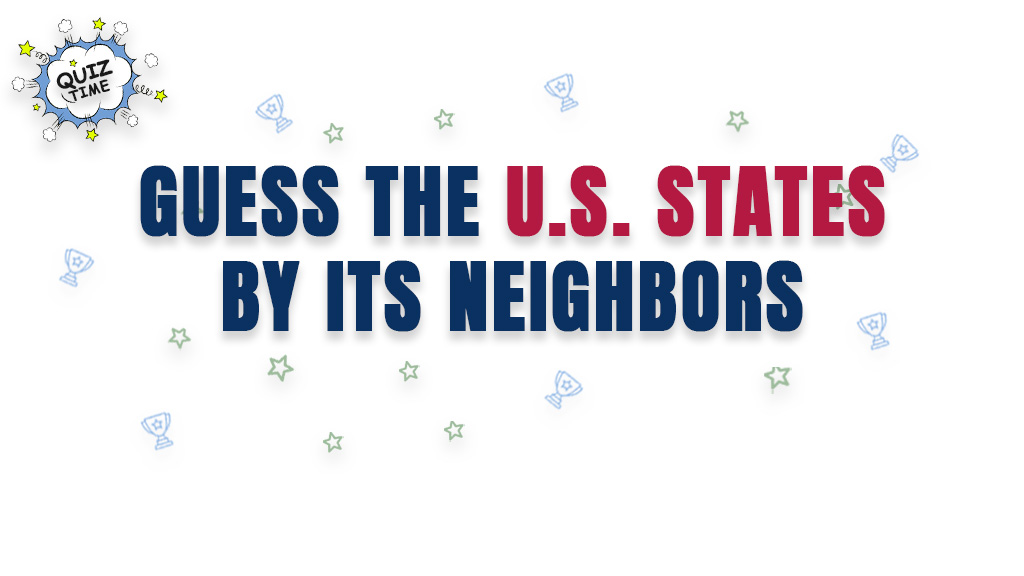❤️It's Trivia, but Sweeter❤️
Guess The U.S. States By Its Neighbors

In the United States, each state is defined not only by its own borders but also by the states that surround it. Understanding these geographic connections is an essential part of studying U.S. geography. The relationships between neighboring states often reveal patterns that can tell us about the country’s physical landscape, cultural zones, and even economic ties. By recognizing which states share borders, one can develop a deeper understanding of the U.S. map and its diverse regions.
Geography plays a crucial role in shaping the culture and identity of a state. States with shared borders often share similarities in climate, industry, and even lifestyle. For instance, states that are located in the Midwest tend to have similar agricultural industries and similar weather patterns, with harsh winters and temperate summers. Similarly, states on the East Coast, like Maine and New Hampshire, are known for their coastal economies, maritime industries, and a rich history tied to early American colonization.
The United States is divided into 50 states, each of which is bordered by one or more other states. While some states share borders with many others, others have fewer neighboring states. Some of the most geographically significant states include California, Texas, and Florida, which are surrounded by other important states and are crucial economic players on the national stage.
For instance, California shares its borders with Oregon to the north, Nevada to the east, and Arizona to the southeast. This placement makes California a key player in both the western U.S. economy and global trade. The state’s location on the Pacific Ocean also influences its industries, from agriculture in its central valleys to technology hubs in Silicon Valley. In contrast, Arizona, located to the southeast of California, shares borders with New Mexico, Utah, and Colorado, each of which offers a unique cultural and economic influence. New Mexico, for example, is known for its strong ties to Native American history and desert landscapes, while Utah’s industries are influenced by its vast outdoor recreation and tourism sectors.
Meanwhile, Texas stands as one of the largest and most diverse states in the U.S., bordered by Oklahoma to the north, New Mexico to the west, Arizona to the northwest, and Louisiana to the east. Texas’ vast size means it has varying geographic features, including deserts, coastal plains, and forests. These diverse regions also foster a range of industries, from oil and gas production to high-tech innovation, agriculture, and international trade. Texas shares a unique relationship with its neighboring states, especially with Mexico to the south. This international border has made Texas a central point for trade and cultural exchange.
The concept of shared borders extends beyond just geographic influence; it also affects the flow of goods, people, and ideas. States that share borders often collaborate on issues such as transportation infrastructure, environmental concerns, and even tourism promotion. States like Michigan, Ohio, and Pennsylvania are examples of how neighboring states often work together to boost their economies through initiatives in manufacturing, energy, and innovation. The Great Lakes region, where these states are located, serves as a major transportation and shipping route for goods moving between the U.S. and Canada.
The diversity of state borders also reveals patterns of migration and settlement. Some states, like Alaska, have only a few neighboring states, which often makes them more geographically isolated. However, Alaska’s strategic location next to Canada and its vast natural resources make it a unique player in U.S. geopolitics. On the other hand, states like Ohio, which are centrally located, often act as bridges between neighboring regions, facilitating trade and communication across larger parts of the country. These interactions have helped shape regional dialects, cuisine, and cultural identities that are shared by neighboring states.
In addition to economic and cultural connections, borders can also have political significance. For instance, the border between Illinois and Wisconsin has played a role in shaping the region’s political landscape. The Midwest, known for its swing-state status, has experienced significant influence from its neighboring states when it comes to elections, especially in national races. This interconnectedness means that political trends in one state can often spill over into adjacent states, affecting voting patterns and political discourse.
The U.S. states also have differing degrees of physical connectivity depending on their geography. Some states, such as those in the West, have vast expanses of wilderness between them, while other regions like the Northeast feature more compact states with extensive urban and suburban areas. These differences affect the level of interaction between neighboring states and the ease with which goods and people can cross state lines. In some cases, especially in the more rural parts of the country, it might take hours of travel just to move between two neighboring states. In contrast, states like New Jersey, Connecticut, and Pennsylvania have close-knit border relationships, as they are located in highly populated regions with frequent commuter traffic and dense infrastructure.
In the process of mapping out the borders of these states, it is important to understand both natural and man-made boundaries. Natural borders such as rivers, mountain ranges, and coastlines have historically played a key role in defining the limits of a state’s territory. For example, the Mississippi River serves as a major boundary between several states in the Midwest and South. Other natural features, like the Rocky Mountains, provide not only geographic distinctions but also cultural differences. States like Colorado and Montana are known for their mountain landscapes and outdoor recreation opportunities, and these features influence the lifestyle of residents.
On the other hand, man-made borders, such as those between states like Virginia and Tennessee, have been determined through political negotiations and agreements. These borders, which were often drawn as part of the process of statehood, continue to define the administrative boundaries that govern laws, taxation, and governance. The precise mapping of these lines ensures that each state has a clear identity and is accountable for the people and resources within its borders.
Over time, neighboring states may also form economic or political alliances that help them address shared challenges. For example, the regional cooperation between states like California, Oregon, and Washington in environmental conservation is an example of how shared borders can foster collective action. These states have worked together to address issues such as climate change, forest management, and ocean protection.
In conclusion, the states of the U.S. are interconnected in ways that go beyond simple geographic borders. Understanding the relationships between neighboring states provides insight into the economic, cultural, and political landscape of the country. Whether through shared industries, transportation routes, or cultural influences, neighboring states often work in tandem to shape the broader narrative of American life. Geography is not just about physical space but also about the people, industries, and policies that make up each region. By recognizing the significance of these connections, we can gain a deeper appreciation for how the states of the U.S. fit together to form a cohesive nation



